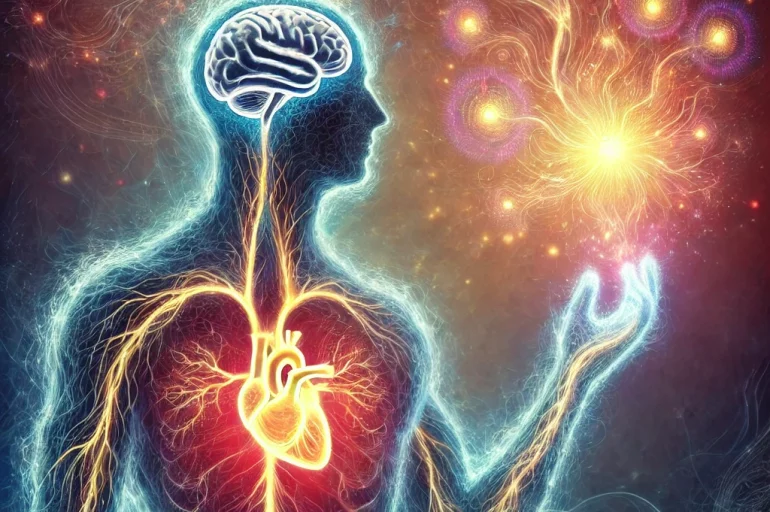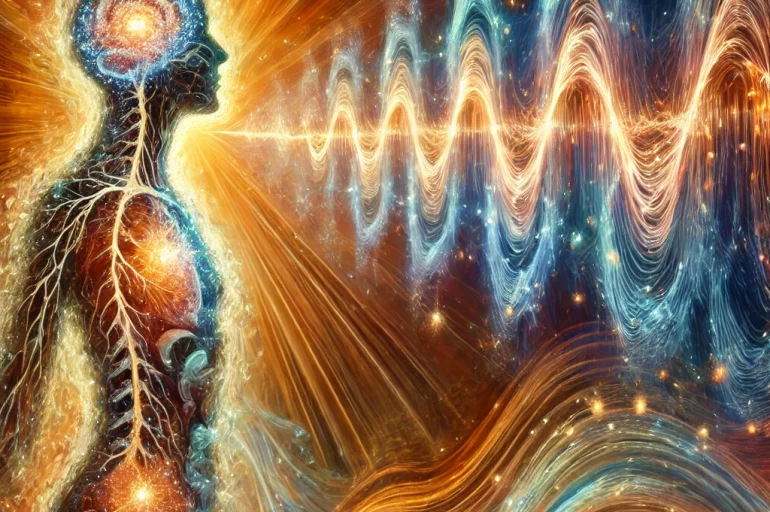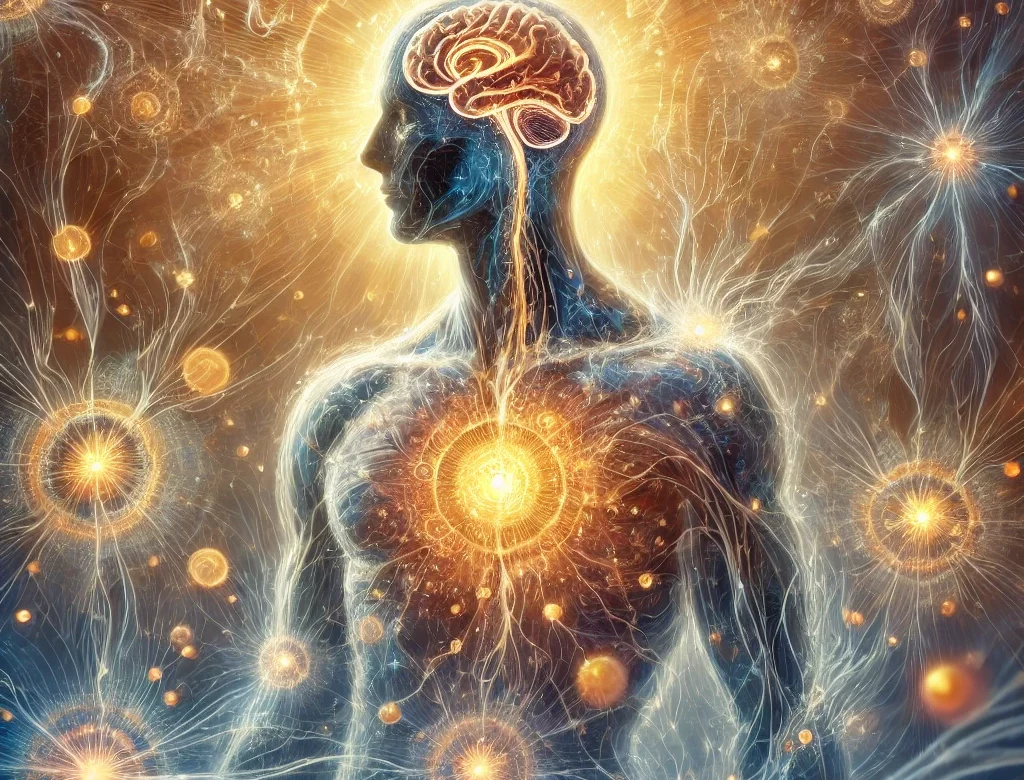The concept of cleaning emotional pain at a cellular level is deeply rooted in both psychological and physiological sciences. While traditional psychotherapy focuses on conscious thoughts and behavioural changes, emerging research in neuroscience, epigenetics, and somatic therapies suggests that emotional trauma is stored in the body down to the cellular and molecular levels.
1. The Science of Emotional Pain at a Cellular Level
Emotional pain is not just a psychological experience; it has biochemical and neurological underpinnings that affect the body’s cells. Research in psychoneuroimmunology (PNI) has shown that trauma and chronic stress can alter the function of immune cells, neurotransmitters, and even gene expression (epigenetics) (McEwen & Morrison, 2013).
- Neurochemical Imprints of Trauma: When we experience deep emotional pain, the body releases stress hormones such as cortisol and adrenaline, which can become dysregulated over time, leading to chronic inflammation and cellular damage (Yehuda et al., 2015).
- Epigenetic Changes: Studies show that trauma can modify gene expression, making individuals more susceptible to anxiety, depression, and chronic illness (Meaney, 2010). The trauma doesn’t change the DNA itself, but it alters how genes are expressed—often locking the body into a stress-response mode.
- Cellular Memory Hypothesis: Some researchers propose that cells “remember” trauma through biochemical changes, affecting how we respond to stressors even years after an event (Porges, 2011).
2. How Emotional Pain Manifests in the Body
Unresolved emotional pain does not just affect the mind—it can manifest physiologically in various ways, including:
-Chronic fatigue and inflammation (Bower et al., 2014)
-Digestive issues due to the gut-brain connection (Mayer et al., 2015)
-Autoimmune disorders, where stress and trauma contribute to immune dysregulation (Dube et al., 2009)
-Muscle tension and chronic pain, often linked to stored trauma in the nervous system (van der Kolk, 2014)
-Heart disease, with studies linking emotional trauma to increased cardiovascular risk (Tawakol et al., 2017)
-Asthma, which has been associated with early-life trauma and emotional distress (Rosenberg et al., 2017)
Dr. Gabor Maté, in his research on mind-body health, emphasises how emotional suppression and unresolved trauma contribute to disease. He explains that “emotions that are not processed become embodied”, leading to chronic health conditions (Maté, 2003).

3. Methods to Clear Emotional Pain at a Cellular Level
To “clean” emotional pain at a cellular level, mind-body approaches are essential. Here are some science-backed methods:
At Counselling and Psychotherapy Services for Men in Sydney, Christian Acuña provides a holistic approach to healing trauma—addressing not only cognitive and emotional distress but also how trauma is stored in the body. Somatic therapy acknowledges that unresolved trauma is not just psychological—it manifests physically, shaping the nervous system and influencing daily behaviours, relationships, and overall well-being. Christian integrates body-based techniques to help clients release deeply stored emotional pain, regulate their nervous system, and develop a sense of safety in their own bodies.
1. TRE (Tension & Trauma Release Exercises)
How it Works: TRE (Tension & Trauma Release Exercises), developed by Dr. David Berceli (2008), is a powerful somatic practice that uses a series of physical exercises to activate the body’s natural tremor mechanism. These tremors, similar to shaking after a stressful event, are the body’s way of releasing deep muscular tension and processing trauma.
How Clients Experience TRE at Christian Acuña’s Clinic:
- Christian guides clients through gentle exercises that fatigue certain muscle groups, allowing neurogenic tremors to emerge.
- This shaking response discharges stored tension and stress in a safe, controlled therapeutic environment.
- Clients often report feeling a sense of lightness, relaxation, and emotional relief after TRE, as their nervous system gradually resets.
Who Can Benefit:
- Clients dealing with chronic stress, PTSD, or high anxiety.
- Those who feel constantly on edge, hypervigilant, or emotionally disconnected.
- Men who experience unexplained body tension, back pain, or headaches linked to psychological stress.
2. EMDR (Eye Movement Desensitisation and Reprocessing)
How it Works: EMDR, developed by Dr. Francine Shapiro (1989), is an evidence-based therapy that reprocesses traumatic memories so they no longer trigger overwhelming emotional or physical responses. It uses bilateral stimulation (eye movements, tapping, or sound tones) to desensitise distressing memories and reframe them in a more adaptive, less distressing way.
How Clients Experience EMDR at Christian Acuña’s Clinic:
- Clients begin by identifying specific distressing memories or triggering situations.
- Christian facilitates bilateral stimulation (eye movements, hand tapping, or auditory cues) while guiding clients through trauma reprocessing techniques.
- Over multiple sessions, the emotional intensity linked to traumatic events diminishes, allowing clients to integrate these experiences without emotional overwhelm.
- Many clients no longer experience panic attacks, nightmares, or flashbacks related to past trauma.
Who Can Benefit:
- Clients with PTSD, childhood trauma, or unresolved emotional wounds.
- Those struggling with fear, intrusive thoughts, or self-sabotaging patterns.
- Individuals who feel “stuck” in past emotional pain, unable to move forward in relationships or life.
3. Polyvagal Theory-Based Practices
How it Works: Based on Dr. Stephen Porges’ Polyvagal Theory (2011), these practices focus on stimulating the vagus nerve to shift the nervous system from a state of chronic stress (fight/flight/freeze) into a regulated state of calm and connection.
How Clients Experience Polyvagal Practices at Christian Acuña’s Clinic:
- Christian teaches clients breathing techniques, vocal toning, and safe touch exercises that stimulate the vagus nerve, promoting a parasympathetic nervous system response (rest and digest mode).
- Clients engage in guided breathwork, such as slow diaphragmatic breathing and humming techniques, to regulate their emotional states.
- Sessions may include mindful movement, cold exposure discussions, or therapeutic grounding techniques to train the nervous system for long-term resilience.
Who Can Benefit:
- Clients dealing with chronic anxiety, panic attacks, or dissociation.
- Individuals who have difficulty feeling safe, present, or emotionally connected in relationships.
- Those who experience shutdown responses, avoidance behaviours, or emotional numbness.
Why Somatic Therapy Matters for Men’s Mental Health

Many men internalise emotional distress, leading to chronic tension, digestive issues, cardiovascular problems, and burnout. By incorporating somatic therapy, trauma release, and nervous system regulation techniques, Christian Acuña helps clients not just process trauma cognitively, but release it physically, creating lasting change in emotional and physical well-being.
B. Breathwork & Cellular Detoxification
Breathwork practices such as Holotropic Breathwork and Wim Hof Method activate the parasympathetic nervous system, reduce inflammation, and release stored trauma in tissues (Sukhin, 2020).
C. Fasting & Cellular Regeneration
Intermittent fasting and practices like autophagy (cellular self-cleaning) have been linked to the removal of damaged proteins and cellular repair, helping the body process unresolved emotional stress at a molecular level (Yoshinori Ohsumi, Nobel Prize in Medicine, 2016).
D. Psychedelic-Assisted Therapy
While Christian Acuña at Counselling and Psychotherapy Services for Men in Sydney does not offer psychedelic-assisted therapy, individuals interested in these treatments can consider the following options:
-
Authorised Psychiatrists: Only psychiatrists who have received approval from the TGA can prescribe MDMA and psilocybin. These professionals must undergo specialised training in psychedelic-assisted therapies and obtain authorisation through a Human Research Ethics Committee (HREC). mindmedicineaustralia.org.au
-
Psychedelic-Assisted Therapy Clinics: Australia’s first psychedelic therapy clinic opened its doors recently, offering treatments for PTSD and treatment-resistant depression.
-
Integration Therapists: For individuals who have undergone or are considering psychedelic experiences, integration therapists can help process and incorporate these experiences into daily life. While not administering psychedelics themselves, these therapists provide valuable support. In Sydney, professionals like Dr. Maria-Elena Lukeides offer such services.
Considerations and Safeguards
It’s essential to approach psychedelic-assisted therapy with caution:
-
Clinical Settings: Ensure treatments are conducted in controlled, clinical environments under the supervision of qualified professionals.
-
Regulatory Compliance: Verify that any psychiatrist or clinic offering these therapies complies with TGA regulations and holds the necessary authorisations.ek therapists trained in helping individuals process and integrate their psychedelic experiences safely.
For more information on psychedelic-assisted therapies in Australia, organisations like Mind Medicine Australia provide resources and updates on the evolving landscape of these treatments. Christian Acuña does not provide psychedelic-assisted therapy, there are authorised avenues in Sydney and broader Australia for those considering such treatments. It’s imperative to engage with qualified professionals and ensure all treatments are conducted within the legal and ethical frameworks established by Australian health authorities.
E. Meditation & Visualisation
Mindfulness practices like Loving-Kindness Meditation (LKM) have been shown to reduce stress markers in the body, enhance telomere length (linked to cellular ageing), and promote emotional healing (Epel et al., 2009).
4. What Christian Acuña Can Offer
At Counselling and Psychotherapy Services for Men in Sydney, Christian Acuña integrates both psychological and somatic approaches to help individuals heal not just mentally, but at a physiological and cellular level. His practice incorporates:
- Compassionate Inquiry (based on Gabor Maté’s work) to uncover deeply stored emotional pain.
- Mind-body integration techniques to regulate the nervous system.
- Attachment-focused therapy to address childhood trauma affecting current relationships.
- Somatic practices that encourage cellular release of stored trauma.
Final Thought
Cleaning emotional pain at a cellular level requires more than cognitive awareness—it involves nervous system regulation, deep somatic release, and biochemical shifts. By addressing emotional wounds through science-backed methods, individuals can truly reset their bodies and minds for long-term healing.
Would you like to explore how these methods can be incorporated into your personal healing journey? Let’s discuss the best approach for you.
References
- Adverse Childhood Experiences Study (Felitti et al., 1998) – How childhood trauma impacts long-term health.
- McEwen, B. S., & Morrison, J. H. (2013). The brain on stress: Vulnerability and plasticity of the prefrontal cortex over the life course. Neuron, 79(1), 16-29.
- Yehuda, R., et al. (2015). Post-traumatic stress disorder: The biological foundations. American Journal of Psychiatry.
- Maté, G. (2003). When the Body Says No: The Cost of Hidden Stress. Wiley.
- Porges, S. W. (2011). The Polyvagal Theory: Neurophysiological Foundations of Emotions, Attachment, Communication, and Self-Regulation. W. W. Norton & Company.
- Epel, E., et al. (2009). Meditation and telomere length: A connection to cellular aging. Psychoneuroendocrinology, 34(4), 529-539.
- Carhart-Harris, R. L., et al. (2018). Psychedelic therapy for trauma-related disorders: Mechanisms and clinical applications. Neuropharmacology.
- van Schie, C. C., et al. (2020). The neural basis of trauma-related disorders and their treatment: A meta-analysis. Neuroscience & Biobehavioral Reviews.
- Yoshinori Ohsumi (2016). Nobel Prize in Medicine for discoveries on autophagy and cellular renewal.
- Tawakol, A., et al. (2017). Neural activity, inflammation, and the link between stress and cardiovascular disease. The Lancet.

